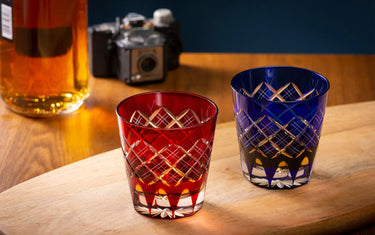Delicate and elegant, "Edo Kiriko" glassware is a traditional craft developed in the city of Tokyo. With special traditional techniques, each glassware is carefully hand-made by craftsmen.
In this article, please discover the beauty and the characteristics of Edo Kiriko glassware, that is suited for daily use as well as for special occasions.
The products we used:

KIMOTO GLASS TOKYO Edo Kiriko Old Fashioned Glass Layered Yarai Blue
Click here for the product pageWhat is Edo Kiriko glassware?

Edo Kiriko is a traditional glasswork craft developed in Tokyo, which was once called Edo in the past.
Engraving designs by glass cutting techniques, Edo Kiriko is known for its unique, elegant and delicate patterns.
The manufacturing of Edo Kiriko glassware has a long history. In the past, the patterns were cut on the surface of transparent glass. With the development of glassware technology, colored glass has been used in recent years.
Engraved on blue or red glasses, the beautiful geometrical patterns shine with light, mesmerizing our eyes.
History of Edo Kiriko craftwork
It is said that the Edo Kiriko glassware originated from a vidro shop at Odenmacho, in the city of Edo (now Tokyo). A glass craftsman has found a technique to create patterns on the surface of the glass using emery powder called "kongosha".
The first glass factory was established in 1873, as a part of the Japanese government's industrial development policies. It was a huge step forward in the development of modern glass crafting techniques.
In 1881, an English cut glass expert, who had the best glass cutting techniques in the world, was invited to the Japanese glass factory, developing further the modern glass cutting techniques.
In the beginning of the 1900s, Edo Kiriko glassware was highly popular, increasing the number of glassware manufacturers and factories in the country. The production techniques for glassware thus improved during this period.
Around 1970, the Japanese government encouraged the promotion of traditional craftwork and local industry. As a result, Edo Kiriko glassware was selected as one of the traditional crafts of Tokyo. Now it is known as one of the famous traditional craftworks in Japan.
Edo Kiriko's production process

The Edo Kiriko production process starts with "Sumitsuke" or "Waridashi", in which designs are hand-painted with ink directly on the surface of the glass without using sketches.
The surface of the glass is then cut in accordance with patterns marked by the Sumitsuke process with a whetstone.
After cutting roughly in accordance with marked patterns, the next step is called the Arazuri process.
In the Arazuri process, the surface of the glass is cut with metal grinding wheel known as "Kanaban". The emery powder paste called "kongosha" is applied to the surface of the grinding wheel in this process.
After going through the Arazuri process several times, the glass is carefully polished for smoothing out the engraved patterns. During this process, the patterns are cut in fine details while fixing small scratches created by the sand. Lastly the glassware is carefully polished and applied chemical processing for giving the extra sparkle in the finished product.
Each of these steps contributes to creating the delicate and beautiful designs of Edo Kiriko glassware.
How to handle with care
Edo Kiriko glassware is extremely fragile and can easily break when hit against a hard object, so please handle it with care. It may also cause breakage by sudden changes in temperature. Please refrain from pouring hot water in it.
It is highly recommended to store in a safe place, keeping out of reach of children and pets.
Please do not use the glassware in the microwave nor in the oven.
How to clean with care

Edo Kiriko glassware is not dishwasher safe, because sudden changes in temperature or shocks caused by high water pressure may cause breakage.
To clean it, put the glassware in warm water with diluted dish soap. Carefully wash it with a soft sponge or cloth.
Also avoid using abrasive dish soap as well as metal or hard scrub brushes that may damage the glass.
Enjoy the delicate beauty of Edo Kiriko glassware
The unique and beautiful Edo Kiriko glassware can add a tint of elegance to your everyday life.
You can use this beautiful glassware for daily drinking at home. It is also perfect as a gift for your loved ones.
We hope you can feel the rich Japanese tradition and history from Edo Kiriko glassware.
The products we used:

KIMOTO GLASS TOKYO Edo Kiriko Old Fashioned Glass Layered Yarai Blue
Click here for the product page













